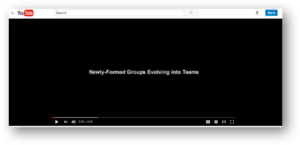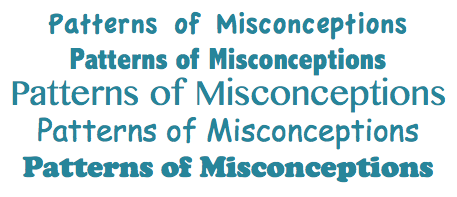by Aaron S. Richmond, Ph. D., Metropolitan State University of Denver
As a standalone assessment tool, the Immediate Feedback Assessment Technique (IF-AT) has been demonstrated to affect student learning and students’ perceptions of the teacher (e.g., Brosvic et al. 2006; Slepkov & Sheil, 2014) and possibly improve metacognition (see Richmond, 2017). However, can IF-AT be combined with a cooperative learning activity such as Team-Based Learning (TBL) to enhance metacognition as well?
To partially answer this question, several researchers suggest that the IF-AT may be used effectively with TBL (Carmichael, 2009; Hefley & Tyre, 2012; Ives, 2014). For example, you could first form teams, give them an exam to discuss and debate the correct answer, and then have the teams decide on the correct answer. If students within a team cannot come to a consensus  on the response to a question, you may allow them to write an “appeal” to turn in a separate answer. Click on Figure 1 for a video on how to use IF-AT combined with TBL. IF-AT may also be used in dyads to allow students to discuss correct and incorrect answers. Students read a question, discuss the correct and incorrect answers, and then cooperatively make a decision, with the IF-AT providing immediate feedback. A third way, suggested by Ives (2011), is to do a two-stage group quiz. Ives suggests that you should have individual students write weekly quiz questions (first-stage), then get into teams and take quizzes in teams that consist of student’s written questions. However, the question then becomes, can the combination of TBL and IF-AT instructional strategies improve metacognition?
on the response to a question, you may allow them to write an “appeal” to turn in a separate answer. Click on Figure 1 for a video on how to use IF-AT combined with TBL. IF-AT may also be used in dyads to allow students to discuss correct and incorrect answers. Students read a question, discuss the correct and incorrect answers, and then cooperatively make a decision, with the IF-AT providing immediate feedback. A third way, suggested by Ives (2011), is to do a two-stage group quiz. Ives suggests that you should have individual students write weekly quiz questions (first-stage), then get into teams and take quizzes in teams that consist of student’s written questions. However, the question then becomes, can the combination of TBL and IF-AT instructional strategies improve metacognition?
Figure 1. Team-Based Learning Using IF-AT.

The Interplay Among IF-AT, TBL, and Metacognition
As I argued previously (Richmond, 2017), IF-AT may improve student’s metacognition; however, by adding TBL, what metacognitive processes and skills might improve? I see a several metacognitive benefits that may occur when combining these two instructional strategies.
First, the combination of IF-AT and TBL may increase student’s metacognitive awareness. For instance, test anxiety may be reduced in a group setting when using IF-AT (Ives, 2011) because students have the opportunity to debate the answers, hear from others, gather consensus and share responsibility. As the awareness of and conscious effort to reduce test anxiety is part of metacognitive awareness, the combination of TBL and IF-AT may make this process more salient.
Second, using TBL with IF-AT may also increase student’s calibration (e.g., the accuracy of knowing when you know or do not know something). That is, in a cooperative learning activity such as TBL, students are either reinforced with their correct knowledge through the process of debating and discussion of answers OR confronted with their incorrect knowledge by interacting with team members. Consequently, their assessment (calibration) of their knowledge should become more accurate through this process. For example, if a team member accurately identifies a correct answer, and one of the team members (who had the incorrect answer to start with) observes this, they may reflect on their answer, determine why and how they came to the incorrect answer, and change future strategies to study and subsequent estimations of knowledge. Or, an individual team member could consistently get (originally) the correct answer, but always underestimate his or her knowledge. This type of student may gain confidence in their knowledge and become more accurately calibrated.
Third, by combining TBL and IF-AT, there may also be an increase of metacognitive, cognitive, and learning strategy skills. That is, as team members share how, where, what, and why they studied, other team members may incorporate these strategies into their quiver of learning strategies (especially if the team member who suggested it was correct). For example, one team member may explain the elaborative strategy they used effectively to study, and other team members listen and incorporate elaboration into their repertoire of strategies. Or, for example, a team member may consistently get questions wrong and share what strategy he or she uses (e.g., cramming and rehearsal). Other team members observe this, realize that strategy does not appear to work very well, and subsequently rarely use it themselves (we could only wish J).
Based on the above examples, it does seem likely that the combined use of TBL and IF-AT may improve various metacognitive skills.
Concluding Thoughts and The Hallmark of Good Assessments—Evidence
As a SoTL scholar, I would be remiss not to investigate the evidence supporting or refuting the  efficacy of IF-AT and TBL. There are a handful of studies that demonstrate the advantage of using TBL and IF-AT to increase academic performance and enjoyment of class (e.g., Carmichael, 2009; Haberyan, 2007). The combination of IF-AT and TBL has also demonstrated to stimulate small group discussion and identify and correct content misconceptions (Cotner, Baepler, & Kellerman, 2008). However, there appears to be a gap in the research. Specifically, there are several research questions which arise:
efficacy of IF-AT and TBL. There are a handful of studies that demonstrate the advantage of using TBL and IF-AT to increase academic performance and enjoyment of class (e.g., Carmichael, 2009; Haberyan, 2007). The combination of IF-AT and TBL has also demonstrated to stimulate small group discussion and identify and correct content misconceptions (Cotner, Baepler, & Kellerman, 2008). However, there appears to be a gap in the research. Specifically, there are several research questions which arise:
- Does the combination of IF-AT and TBL increase metacognitive awareness?
- Does the combination of IF-AT and TBL increase the accuracy of a student’s calibration?
- Does the combination of IF-AT and TBL increase a student’s repertoire of cognitive and learning strategies?
- What other metacognitive processes may be enhanced by using IF-AT in a TBL setting?
As I mentioned in my first blog on IF-AT (Richmond, 2017) and here, I think there are enormous SoTL research opportunities for investigating the effects of IF-AT and TBL to improve metacognition. This, invariably, leads to the proverbial phrase: A little knowledge is a dangerous thing—so get to work!
Please follow me on Twitter: @AaronSRichmond
References
Carmichael, J. (2009). Team-based learning enhances performance in introductory biology. Journal of College Science Teaching, 38(4), 54–61.
Clark, M. C., Nguyen, H. T., Bray, C., & Levine, R. E. (2008). Team-based learning in an undergraduate nursing course. Journal of Nursing Education, 47, 111–117.
Cotner, S., Baepler, P., & Kellerman, A. (2008). Scratch this! The IF-AT as a technique for stimulating group discussion and exposing misconceptions. Journal of College Science Teaching, 37(4), 48.
Haberyan, A., (2007). Team-based learning in an industrial/organizational psychology course. North American Journal of Psychology, 9,143–152.
Hefley, T., & Tyre, A. J. (2012). Favorable team scores under the team-based learning paradigm: A statistical artifact?. RURALS: Review of Undergraduate Research in Agricultural and Life Sciences, 6(1), 1. Retrieved from http://digitalcommons.unl.edu/cgi/viewcontent.cgi?article=1043&context=rurals
Ives, J. (2011). Two-stage group quizzes part 1: What, how and why. Science Learnification: Teaching and learning in the sciences with a focus on physics education research (PER) from the trenches. Retrieved from https://learnification.wordpress.com/2011/03/23/two-stage-group-quizzes-part-1-what-how-and-why/
Richmond, A. S. (2017, February 24th). Scratch and win or scratch and lose? Immediate Feedback Assessment Technique. Retrieved from https://www.improvewithmetacognition.com/scratch-win-scratch-lose-immediate-feedback-assessment-technique/
Slepkov, A. D., & Shiell, R. C. (2014). Comparison of integrated testlet and constructed-response question formats. Physical Review Special Topics-Physics Education Research, 10(2), 020120.



